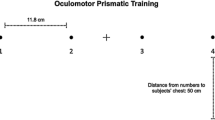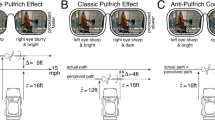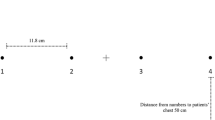Abstract
For 1 week, healthy human participants (n=7) were devoid of normal vision by exposure to prism lenses that optically rotated their perceived world around the line of sight by 180°. Adaptation to such prisms involved sustained and vigorous practice of the ability to redirect the unadapted efferent motor command; because prior to all visually guided movements, the to-beexecuted efferent command was based on incorrect (prismatically reversed) spatial information. The time course of this sort of adaptation was systematically explored in Cooper-Shepard mental rotation (MR) tests and in naturalistic motor-tasks for the purpose of investigating whether mental rotations of the direction of the intended movement share common aspects with the process of MR. A control group (n=7) intermittently exposed to the distorted spatial organization of the central visual field was studied in parallel. The main results were as follows: (a) the MR reaction times (RTs) day 1 with prisms appeared to be very similar to the normal RTs (day 1, noprisms) with the one exception that subjects now responded within a prism (rotated) frame of spatial reference rather than within the environmentally upright. The visuomotor performance became grossly irregular and dysmetric. (b) The majority of the visuomotor adaptation functions began to level off on the 3rd day. (c) The increases in natural motor proficiency were accompanied by a systematic and noticeable decrease in magnitude of the MR Y-intercept obtained from the linear regression line calculated between each subject’s RT and the various stimulus angles. MR slopes were stable through days 1–7 for both the experimental and control group. An increased correlation between rotational stimulus angle and RT suggested that the MR function also became progressively more tightly coupled to the stimulus angles. (d) Postadaptation measures of performance indicated the occurrence of selective and minimal adaptation in the natural motor tasks only. It is suggested that these results reflect an improved attentional (strategic) ability to replace incorrect (error producing) control signals with correct (error reducing) control signals. As a result, perceptual- motor start-up processes directly related to spatial coding and to the planning, initiation and correction of the intended direction of motor-or-mental movement improved while the subprocess (“stage”) concerned with transformations of such movements remained unchanged. Visuomotor adaptation to inverting prisms engages, and thereby stimulates, a cortical system also invoked in the preparatory process of MR.
Similar content being viewed by others
Author information
Authors and Affiliations
Corresponding author
Rights and permissions
About this article
Cite this article
Richter, H., Magnusson, S., Imamura, K. et al. Long-term adaptation to prism-induced inversion of the retinal images. Exp Brain Res 144, 445–457 (2002). https://doi.org/10.1007/s00221-002-1097-6
Received:
Accepted:
Published:
Issue Date:
DOI: https://doi.org/10.1007/s00221-002-1097-6




